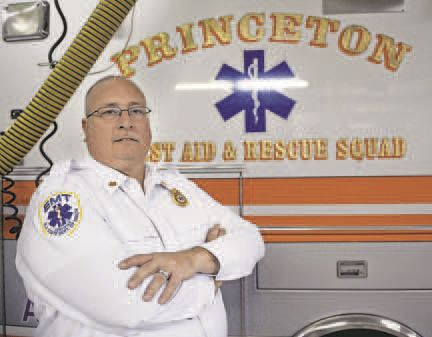By Lea Kahn, Staff Writer
Frank Setnicky knew something was up when he was advised to attend the New Jersey Office of Emergency Medical Services’ annual statewide conference on EMS and its annual awards ceremony in Atlantic City.
Mr. Setnicky, who is the Princeton First Aid and Rescue Squad’s operations director, knew that he had been nominated for the Outstanding EMT of the Year — but he did not exactly expect to be standing in front of dozens of his peers, accepting the award last month.
But that’s where he found himself on Nov. 18.
“I was surprised. I never expected it. This is not me. I just do what I do because I like to do it. I just want to help. I’m a ‘people person,’” said Mr. Setnicky, who lives in Clinton.
Mr. Setnicky was nominated for the award by a colleague at the Clinton First Aid and Rescue Squad, where he volunteers in his spare time and also serves as its chief.
Mr. Setnicky, who grew up in Ringoes in Hunterdon County, was introduced to the world of emergency medical services as a teenager. His initial contact was the result of a broken leg as a 13-year-old. He was impressed with the first responders, and joined the Amwell Valley Ambulance Corps one year later, as a cadet.
“They came and they took care of me. I thought it would be something interesting to do,” Mr. Setnicky said. The Amwell Valley Ambulance Corps provided emergency medical services to residents in Ringoes and the surrounding area.
He joined the Amwell Valley Ambulance Corps and became a certified EMT at 16 years old — the first year that state officials allowed 16-year-olds to take the course. The minimum age to take the course and become certified had been 18 years old.
Mr. Setnicky volunteered with the ambulance corps while he was in high school. Upon graduation, he took a job in a factory but decided “this is not the place that I wanted to stay (in) for a long time.” He was reading through some job advertisements and learned that the Princeton First Aid and Rescue Squad needed a full-time EMT.
“I loved doing emergency medical services, so I said, ‘I’ll give it a shot,’” Mr. Setnicky said. He was hired by the Princeton First Aid and Rescue Squad as an EMT in 1986, and was named its operations director in 2007. He is one of the paid employees. The squad includes volunteer EMTs, in addition to the paid EMTs.
When Mr. Setnicky joined the Princeton First Aid and Rescue Squad 30 years ago, it consisted of one crew of paid EMTs who worked during the daytime on weekdays. The 30 volunteer EMTs covered the overnight hours and the weekends.
Today, the Princeton First Aid and Rescue Squad has one paid crew that works a 12-hour shift, seven days per week, and a second paid crew that works Monday through Friday during the day. There are 90 volunteer EMTs who cover the hours when the paid EMTs are not working, and who also respond if extra help is needed.
Back in the day, the EMT course took about 100 hours to complete, he said. Now, the course is 270 hours and means attending classes two nights per week plus Saturdays. While EMTs used to be taught in more general terms what they had to do, the emphasis today is teaching them the reasons why an action is taken, he said.
“It’s more in-depth. You still learn how to control bleeding, cardiopulmonary resuscitation, how to use a splint for a broken bone and how to administer oxygen. Now, you can use an AED (for cardiac patients) and give Narcan for a drug overdose,” he said.
Some of those actions could only have been administered by a paramedic, who has received advanced training beyond the basic EMT level. The decision to expand the scope of actions that an EMT can administer means there is no need to wait for the paramedic to arrive.
Mr. Setnicky said the number of calls that the Princeton First Aid and Rescue Squad answers has jumped from about 1,000 per year when he joined in 1986, to about 3,000 calls per year now. There are more calls, but the medical issues have not changed — diabetic emergencies, cardiac emergencies and fall victims, among others.
“It’s not for everyone,” he said of the job. “There are some not-so-nice things that we see, like traumatic injuries to children. They fall off their bicycle and hit their head, or they are struck by a car. They also can have medical problems. You don’t want to see anyone in pain, but especially when it is a child.”
The EMTs cope with the unpleasant aspects by talking to one another and supporting one another, he said. His support network has expanded to include his wife, who also volunteered as an EMT in Clinton, and his three children, who are volunteers with the Clinton First Aid and Rescue Squad.
Asked why he has stayed on as a paid EMT, Mr. Setnicky replied that it’s just “the drive to help. I like teaching the new members that come in. I look back at the number of people who have come through here and who have gone into the medical and health professions. It’s a good experience.”
“I love being an EMT, and I like coming to my job. I enjoy it. I like being able to help out,” he said, adding that he has no regrets.
“I would do it all over again,” Mr. Setnicky said.

